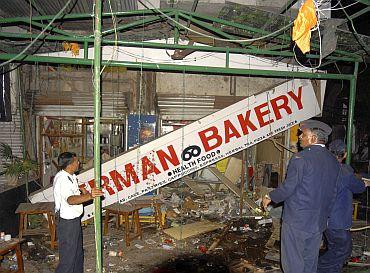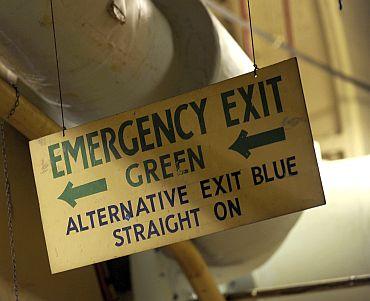Photographs: Jayanta Shaw/Reuters Rediff News Bureau
The bloodbath at German Bakery in Koregaon Park, Pune is a stark reminder of the unpredictable times we are staying in.
There could be intelligence inputs, there could be security but at the end of the day, a little awareness on our behalf could make a little more difference.
Mumbai Police recently released a handbook on how to safeguard people and property from terror attacks.
Based on excerpts from the handbook, rediff.com looks at five possible forms of attack and describes the sort of thing that the security plan should cover in each case. Click on NEXT to know what YOU MUST DO when the time comes...
Plot 1: Bomb on the premises
Image: Images used only for representational purposesPhotographs: Sergio Perez/Reuters
In practice, it is unusual for a bomb containing high explosive (rather than an item delivered through the post or an incendiary) to be found inside a building, although it is not unknown.
It is important to plan for this eventuality, not least because both terrorists and pranksters frequently claim that there is a bomb in the building. A bomb, with its explosive, timing and arming devices and its concealment, represents a considerable investment of planning, determination and skill.
Left within a building, or in some other public space, it represents a very serious attempt at damage and disruption and a disregard for the possibility of the loss of life. The threat call itself can cause economic disruption.
Preparing for the possibility
Planning for a bomb attack inside your office, public areas, car park, storage unit of yard perimeter is based on certain assumptions:
The bomber has to make his or her way inside your perimeter and leave the device in such a way to -- at minimum -- secure his or her getaway.
An attack, whether with high explosive or home-made explosive, is always life threatening; and
There will always be some structural damage, if only broken windows.
Minimising the risk of successful attack
An office block or a factory with access control for staff and visitors (and their cars) offers relatively little opportunity for this sort of attack providing the systems in place are properly applied.
A public place, such as a shop or airport, is more at risk and at times of high alert search of baggage may be the only available means of protection -- and deterrent. The risk of successful attack -- and, equally importantly, the disruption caused by persistent threat calls -- can be minimised by:
Search procedures by staff of their own areas; and
Search procedures for public areas.
Good housekeeping practice comes into its own against this sort of attack. Public and private areas should be kept as clear as possible, with rubbish regularly removed and boxes and equipment stored tidily and in their own recognised places. Regular users, as well as cleaning, maintenance and security staff, should all be encouraged to know what is usually where so that they can spot the unusual.
It is frequently said that any package that is out of place is a suspicious package -- but you will not want to disrupt your business by making your staff anxious about every carelessly dumped bin bag. Their attitude to keeping their patch free of clutter will make them feel safer, deter a potential attacker -- and make searching much simpler if a threat is made against you.
Dealing with the Event
The internal bomb attack is most often experienced as a terrorist hoax or a prank. However the potential damage, injury and loss of life could be severe. So the contingency plan in this case must cover both the handling of a threat call and the discovery of a suspicious item, and should involve:
Immediate notification to the police of any threat;
Pre-set plans for reacting to the threat call;
Pre-set, easily displayed and practised plans for evacuating to a place of safety;
Pre-set and practised means of communicating evacuation plans to visitors; and
Means for securing the site against entry until the police have allowed access again.
Plot 2: Bombs outside the building
Image: Images used only for representational purposesPhotographs: Stringer/Reuters
The vehicle bomb represents an extreme form of terrorist attack, designed to cause maximum economic damage, both short and long term.
The risk of large numbers of casualties and deaths is great because of the large-scale structural damage that invariably results. Generally, vehicle-borne bombs comprise home-made explosive in large quantity, involving a high degree of pre-planning, commitment and expertise.
They are frequently accompanied by threat calls and once again it is important to be able to deal with the disruption caused by terrorist hoaxes or pranksters as well as with the incident itself.
There is also the chance that bombs will be left in streets, parks and other public places and in bags, briefcases and parcels. The potential for loss of life, injury and disruption is still high although the long-term damage may not be so extensive.
Preparing for the possibility
Plans for dealing with the chance of injury to your staff or damage to your property from a device outside your building have to be one key issue:
Evacuation always carries a certain risk, either of staff moving closer to, rather than away from, the bomb (since warnings are rarely explicit) or of moving into the open where they may be at risk more from falling masonry and flying glass than the blast itself.
On this basis, occupiers of buildings should establish whether "internal evacuation" to a bomb shelter within the building is a viable option. This will depend on the structure of the building and detailed advice on the features that a structural engineer should examine is readily available via police.
In a bomb shelter area, staff can be assured that whatever structural damage occurs to their building of those surrounding it, they will be safer until the emergency services can give them the all clear to leave.
Dealing with the event
Plans should cover the following:
Immediate notification to the police of any threat
Pre-set plans for reacting to the threat call; and
Pre-set easily displayed and practised plans for evacuating to a place of safety (which may be either a bomb shelter area or an external site)
Plot 3: The delivered bomb
Image: Images used only for representational purposesPhotographs: Reuters
Most organisations receive huge amounts of mail, whether through the Post Office or other delivery and courier firms. This is an attractive route into your building or into your hands. It is a targeted attack.
The aim is to kill or maim or disrupt, not to cause structural damage or mass casualties. The nature of your business and the current focus of terrorism or "activism" will give you, in consultation with the local police, a reasonable picture of how likely this form of attack is, and this will dictate just how for you want to go in your planning.
Preparing for the possibility
Planning for the delivery of an explosive or incendiary device is based on two simple features:
It will already have undergone some fairly rough handling, by the Post Office or by its courier.
Uncertainty over exact delivery times, and the weight and complexity of reliable timing devices, makes it very unlikely that the device will be triggered by a timer.
Handling delivered mail is therefore not generally dangerous in itself.
Recognising a suspicious item
The police can give guidance on the features that may identity the typical letter or parcel bomb. And staff who handle mail can be helped to pick out potentially "suspicious" items by building good housekeeping measures into usual business routines:
Let staff know what is the usual pattern of deliveries and the types of item, and forewarn when unusual deliveries are expected; and
Encourage good practice in those you deal with regularly by having a clearly identifiable sender shown on each item.
Make sure that you have identified and briefed all staff, who handles delivered items (think of Reception as well as the Mail Room).
If the risk and scale of the problem for you is sufficiently great you may want to invest in commercially available X-ray or other equipment. The police can advise. This equipment is only as good as its operations and you will need a regular programme of training and checking to see that procedures are followed.
Dealing with the event
If you have detected a suspicious item:
Leave it alone (do not play with it to investigate it further, do not put it in a bucket of water or put something on top of it or throw it out of the window);
Clear and secure the immediate area; and
Call the police
Plot 4: Incendiary devices
Image: Images used only for representational purposesPhotographs: Toby Melville/Reuters
Incendiary devices are traditionally the weapon of choice against the retail sector, and occasionally against certain industries or public buildings. They may form part of a targeted attack (because of who the company is or what it sells) or the placing may be relatively random (if the aim is to damage a town centre or shopping mall itself).
The purpose is to cause economic damage (directly and via publicity), not casualties.
Preparing for the possibility
Planning against the possibility that an incendiary attack will be mounted against you is based on some basic assumptions:
The device will be concealed for ignition when the premises are empty;
As damage is the objective, having more than one potential seat of fire is attractive to the attackers;
Anything that triggers a sprinkler system will, because of the damage ensuing, be a good result even if total destruction is not achieved; and
Incendiary devices do not explode, they ignite.
Minimising the risk of successful attack
Generally speaking the business need for continued mass public access will preclude any major screening programmes to search for devices being brought in, except at periods of the highest alert. The contingency plan should provide for:
A search at the end of each day's business;
A continued search after the discovery of one item; and
Plans for a discreet search during business hours in a time of high risk
Devices will be carefully but not elaborately concealed, and the staff searching will not therefore need a high degree of knowledge to carry out rapid but thorough searching of easily accessible hiding places. All staff can maintain vigilance for those acting oddly in their areas.
Dealing with the event
If an incendiary device has been discovered during search or by chance:
Do not touch it;
Clear and secure the immediate area; and
Call the police
Even if staff have been trained, the possibility of multiple attack by incendiaries should be remembered, and staff and visitors evacuated according to prearranged fire plans.
Plot 5: Telephoned bomb threats
Image: Images used only for representational purposesPhotographs: Punit Paranjpe/Reuters
The phenomenon of telephoned bomb threats has become a commonplace, so much so that they merit a separate section earlier in this booklet.
Planning for the possibility
Plans need to cover two possibilities:
Receipt of a call that refers to your own building; and
Receipt of a call about a bomb elsewhere.
All staff likely to answer your published numbers, in working hours or overnight, should be familiar with the Bomb Threat aide-memoire and pro forma, and have a supply ready to hand.
They need to be fully familiar with any recording facilities or last number redial or display facilities that your switchboard provides. They must know how to contact both the security co-ordinator and the police.
A member of staff who has taken a call must be available to talk to the police.
Dealing with the event
The pro forma will assist staff to handle the call itself and to record the necessary detail.
If the call is threatening an attack elsewhere, your action will end once you have informed the police and handed over any necessary paperwork to them. But the threat may be to your premises, and will involve on your part:
Preliminary assessment of the threat (take it seriously...or not?) If it is a giggling child, you may assume it is a hoax and adopt the "do nothing" approach. But if there is the slightest doubt you should consider.
Initiating your evacuation or search plans, in whatever combination the timescale quoted by the caller and the location quoted by the caller suggests.
Remember, whatever you decide, always report any call to the police.







article